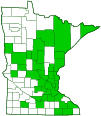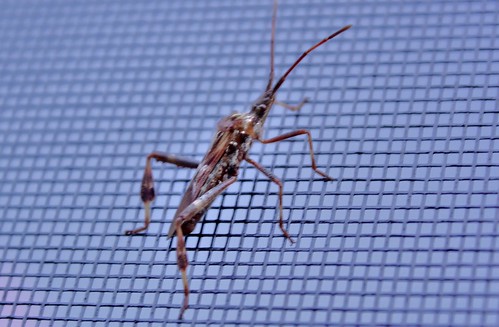western conifer seed bug
(Leptoglossus occidentalis)
Conservation • Description • Habitat • Ecology • Distribution • Taxonomy
|
|
||||||||||||||
Description |
Western conifer seed bug is a common and widespread, terrestrial, true bug. It is most often encountered in the fall, when it seeks shelter for the winter. Adults are ⅝″ to ¾″ in length. The front (anterior) thoracic shield (pronotum) is covered with long, erect hairs. The upper (dorsal) side of the abdomen is mostly hidden by the wings and is rarely visible except in flight. It is orangish-yellow with black markings, including two narrow, elongated, lance-shaped longitudinal marks in the center; and five broad, horizontal patches on each side. There are two pairs of wings, and they are held flat over the body when at rest. Between and at the wing bases there is a triangular plate (scutellum). The forewings (hemelytra) on the mature adult are longer than the abdomen but do not completely cover the sides of the abdomen. The sides of the abdomen are exposed and appear conspicuously striped when the wings are closed. The hemelytra have a thickened section at the base and a thin membranous section at the tip with a clear dividing line between the two. The thickened basal part is comprised of a narrow area (clavus) behind the scutellum when the wings are closed, and the remaining broad marginal area (corium). There is a yellowish-white, horizontal, zig-zagged line on the corium that is narrow and confined to the veins. At the end of the corium there is a small but distinct triangular area (cuneus). The hindwings are thin, membranous, and concealed under the forewings. The head is small, much narrower and somewhat shorter than the pronotum. At the front of the head there is a rounded lobe that projects forward. There is a pair of large compound eyes and a pair of small simple eyes (occelli). The mouth parts are optimized for piercing and sucking. They take the form of a long, 4-segmented beak that extends along the underside of the body between the legs. It consists of 4 hair-like blades (stylets) with sharp tips enclosed in a 4-segmented sheath. There are two channels in the beak, one spitting out saliva to keep the food flowing, and one for sucking in liquid food. The two lower jaw-like structures (maxillae) and two lower lips do not have feeler-like structures (palpi) attached. The antennae are exposed, conspicuous, and long, much longer than the head. They have four segments. The first segment is chestnut orange with a black longitudinal stripe. The third segment (femur) of the hind leg is is stout and spurred below. The fourth segment (tibia) is greatly dilated. The dilations are nearly equal in length and are less than 70% of the length of the tibia. They are lance-shaped and are not scalloped. The outer dilation is slightly wider than the inner. The feet (tarsi) have only 3 segments. |
Size |
Total length: ⅝″ to ¾″ |
Similar Species |
Habitat |
|
Ecology |
Season |
One generation per year: Late May to the onset of cold weather in the fall |
Behavior |
When in flight the wings create a loud buzz. Unlike similar-looking assassin bugs, they do not bite. When handled they squirt a foul-smelling chemical from glands on the sides of their bodies that is an effective deterrent. As the weather turns cold in the fall they often bask in the sun on the south side of human dwellings. |
Life Cycle |
Adults emerge in late May or early June. The female lays rows of 1 ⁄16″ long eggs on needles of host species. The eggs hatch in about 10 days. The young (nymphs) pass through 5 instar stages before becoming an adult. Adults overwinter. |
Nymph Food |
Developing seeds and early flowers of host species |
Adult Food |
Sap from green cones and twigs of pine, hemlock, spruce, and fir. |
Distribution |
||
|
Sources |
|
| 10/30/2024 | ||
Occurrence |
||
Common and widespread |
||
Taxonomy |
|
Order |
Hemiptera (True bugs, Hoppers, Aphids, and Allies) |
Suborder |
Heteroptera (True Bugs) |
Infraorder |
Pentatomomorpha |
Superfamily |
Coreoidea (leaf-footed bugs and allies) |
Family |
Coreidae (leaf-footed bugs) |
Subfamily |
Coreinae |
Tribe |
Anisoscelini |
Genus |
Leptoglossus |
Subordinate Taxa |
|
|
|
Synonyms |
|
Narnia anaticula Theognis occidentalis |
|
Common Names |
|
pine seed bug western conifer seed bug western conifer-seed bug WCSB |
|
Glossary
Corium
The thickened basal portion of the front wing that lies between the clavus and the membrane of insects in the family Hemiptera. Plural: coria.
Femur
On insects and arachnids, the third, largest, most robust segment of the leg, coming immediately before the tibia. On humans, the thigh bone.
Hemelytron
The forewing of true bugs (order Hemiptera), thickened at the base and membranous at the tip. Plural: hemelytra.
Instar
The developmental stage of arthropods between each molt; in insects, the developmental stage of the larvae or nymph.
Ocellus
Simple eye; an eye with a single lens. Plural: ocelli.
Pronotum
The exoskeletal plate on the upper side of the first segment of the thorax of an insect.
Scutellum
The exoskeletal plate covering the rearward (posterior) part of the middle segment of the thorax in some insects. In Coleoptera, Hemiptera, and Homoptera, the dorsal, often triangular plate behind the pronotum and between the bases of the front wings. In Diptera, the exoskeletal plate between the abdomen and the thorax.
Tarsus
On insects, the last two to five subdivisions of the leg, attached to the tibia; the foot. On spiders, the last segment of the leg. Plural: tarsi.
Tibia
The fourth segment of an insect leg, after the femur and before the tarsus (foot). The fifth segment of a spider leg or palp. Plural: tibiae.
Visitor Photos |
||
Share your photo of this insect. |
||
This button not working for you? |
||
Val McGruder |
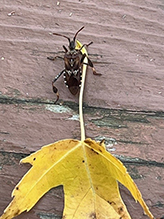 |
Ostry |
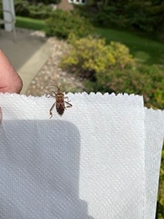 |
Alfredo Colon |
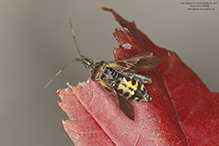 |
Nicky Clark |
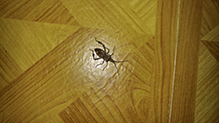 |
Emily |
||
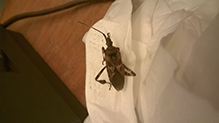 |
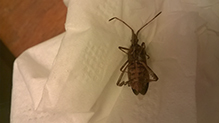 |
|
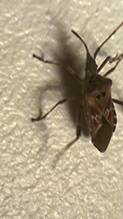 |
||
MinnesotaSeasons.com Photos |
||
|
||
|
||

Slideshows |
Western Conifer Seed Bug |
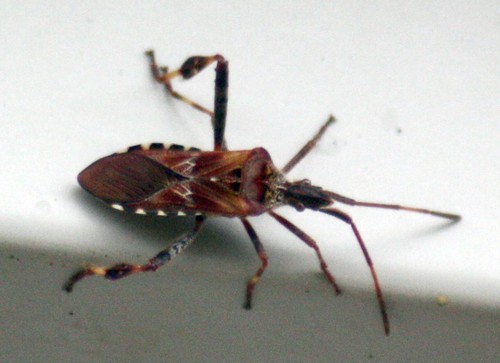
|
About
Copyright DianesDigitals |
Leptoglossus occidentalis (Western Conifer Seed Bug) |
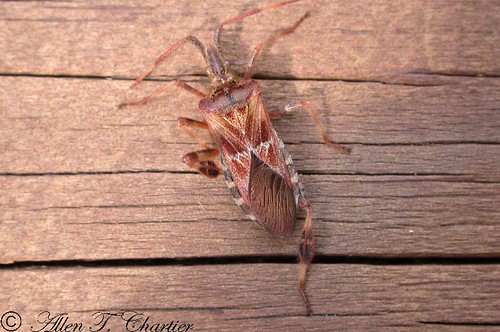
|

Visitor Videos |
||
Share your video of this insect. |
||
This button not working for you? |
||
|
Other Videos |
||
Leptoglossus occidentalis |
About
Published on Dec 30, 2014 Western Leaf-footed Bug found walking majestically in our office this December 30, 2014 , Burnaby, BC |
Invasor Bug - Leptoglossus occidentalis (Heidemann, 1910) - Tiny Tenants |
About
Uploaded on Jan 11, 2012 www.carlosmezo.com |
leptoglossus occidentalis-cimice americana delle conifere |
About
Uploaded on Dec 5, 2011 Originaria degli Stati Uniti occidentali (California, Oregon e Nevada) ove trova il suo habitat naturale, le foreste di conifere, la specie è stata importata anche in Italia. Arriva in Italia probabilmente con l'importazione di legname. Nel 1999 è segnalato in Veneto. Quindi lo si trova anche in Lombardia, Friuli-Venezia Giulia, Trentino, Sicilia ed Emilia-Romagna. Nell'autunno 2006 è stato avvistato anche in Umbria. In Sardegna è ormai diffuso in tutta l'isola[1]. Google Translate: Native to the western United States (California, Oregon and Nevada) where it finds its natural habitat, coniferous forests, the species was imported in Italy. The bug pines (Leptoglossus occidentalis Heidemann, 1910) is an insect pest of the family of Coreidi (Hemiptera Heteroptera).She arrives in Italy probably by importing timber. In 1999, it reported in Veneto. So it is also found in Lombardy, Friuli-Venezia Giulia, Trentino, Sicily and Emilia-Romagna. In autumn 2006 was spotted in Umbria. Sardinia is now widespread throughout the island. [1] Its presence in some less rich conifer is not surprising because the insect lives even at the expense of the pistachio. http://it.wikipedia.org/wiki/Leptoglossus_occidentalis |
Western Conifer Seed Bug (Leptoglossus occidentalis) |
About
Published on Jan 31, 2013 |

Visitor Sightings |
||
Report a sighting of this insect. |
||
This button not working for you? |
||
Val McGruder |
Location: Minnetonka, MN |
 |
| Ostry 9/21/2023 |
Location: Alexandria MN Douglas CO |
Beth |
Location: Morrison County, MN |
|
| Alfredo Colon October 2017 |
Location: Woodbury, MN |
| Emily 10/28/2015 |
Location: Mound MN |
MinnesotaSeasons.com Sightings |
||
|

Created: 10/29/2015 Last Updated: © MinnesotaSeasons.com. All rights reserved. |
